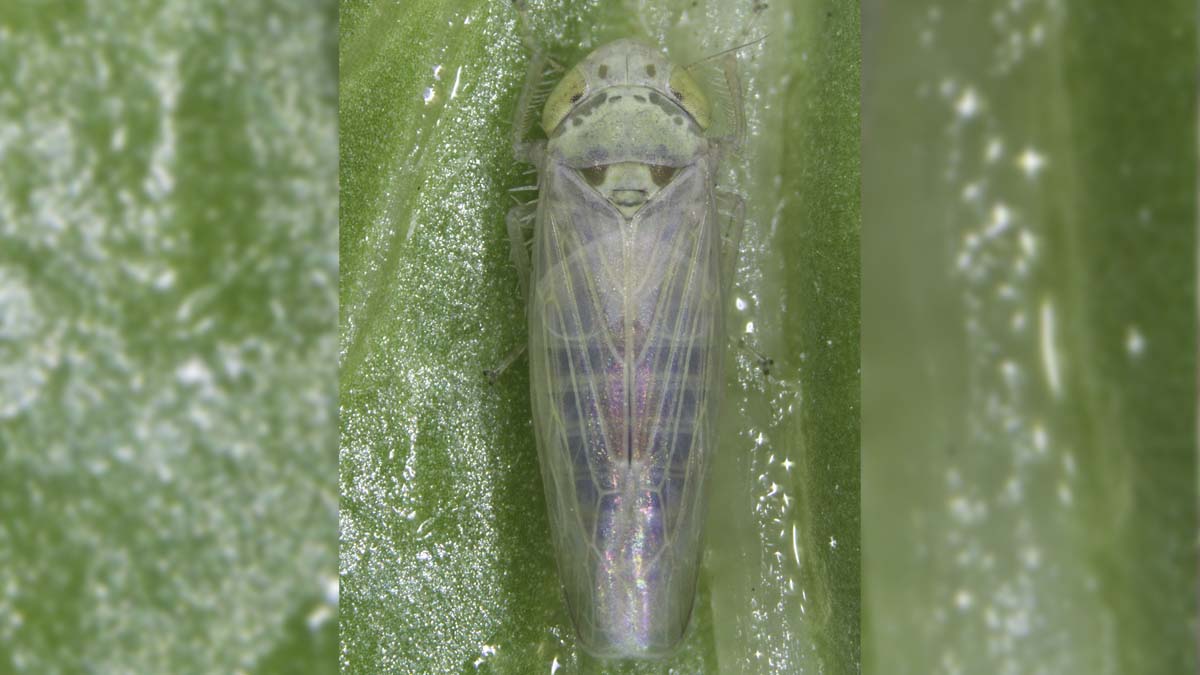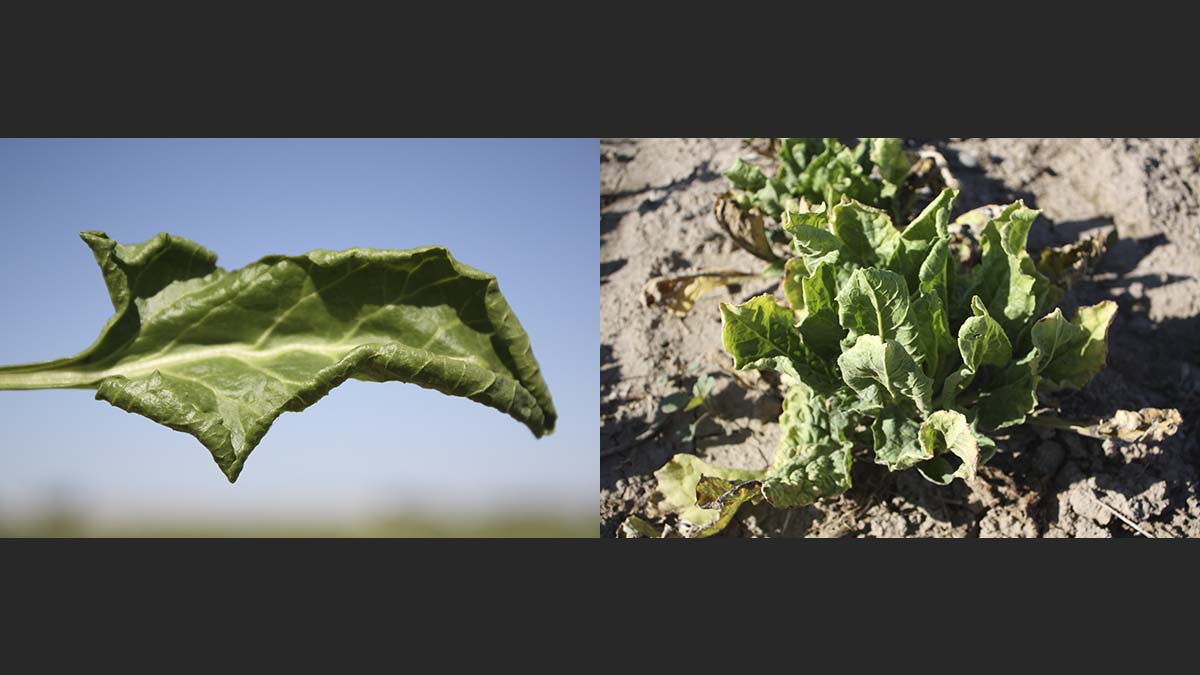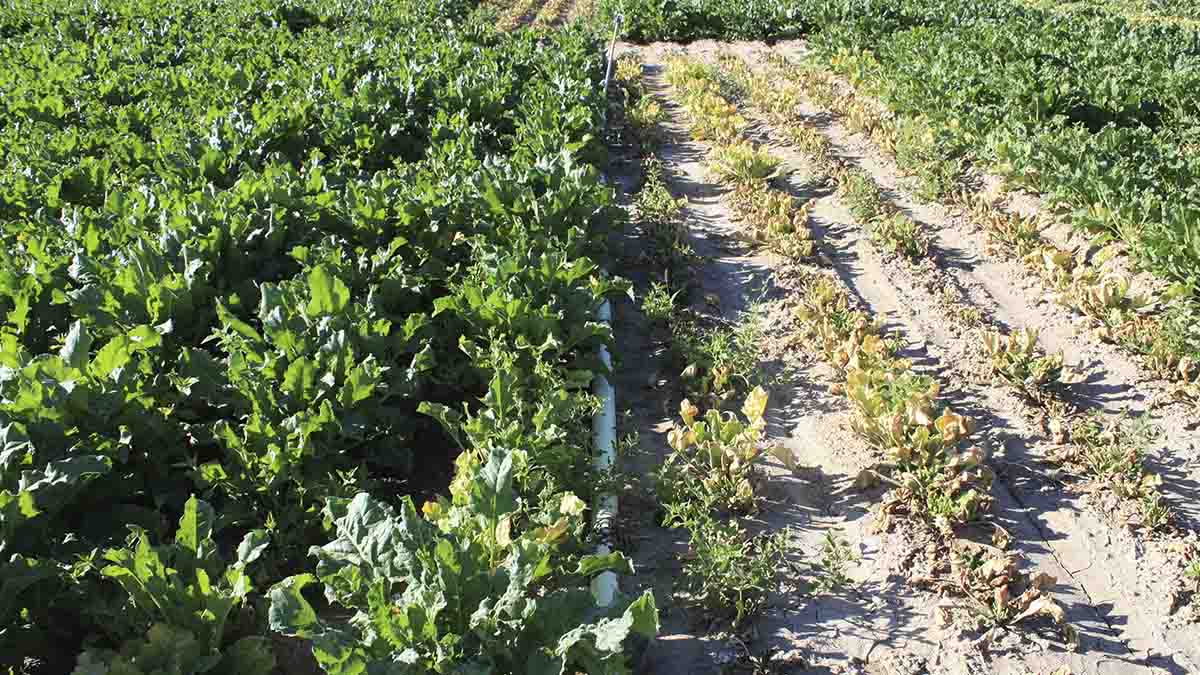Beet Leafhoppers
Pest Common Name
- Beet leafhopper (Circulifer tenellus)
- Other leafhoppers in the genus Empoasca
- Beet, potato, tomato, alfalfa, bean, pepper, others
- Weeds: mustard family weeds, kochia, Russian thistle, pigweed, shepard’s purse, sagebrush, others
Adult leafhoppers are small, wedge-shaped insects, that are yellow to green in color. Adults are approximately 1/8 inch (3 mm) long, with membranous wings held tent-like above the body. Nymphs are similar in appearance, though often lighter in color, and smaller and with underdeveloped wings. Eggs are not easily visible, as they are laid inside plant tissues. As the name suggests, leafhoppers tend to move in rapid, short flights, that resemble “hopping.”
Beet leafhoppers (Figure 1) vary in color but are usually pale green to gray to tan. Beet leafhoppers can be differentiated from some other leafhopper species by the lack of a dark spot on the head but may develop darker coloration later in the season.

Biology
The lifecycle of leafhoppers consists of egg, nymph and adult. There are multiple growth phases or “instars” of nymphs. Eggs are inserted into plant tissues by females.
Adult leafhoppers overwinter in weedy or uncultivated areas. Overwintering females begin laying eggs around March. It takes until about May for these eggs to mature into adults, which then may move into cultivated fields; timing of this movement may occur earlier or later depending on when spring hosts become dry and unsuitable for leafhoppers. Leafhoppers may disperse from overwintering sites to nearby fields, or they may sometimes migrate further on wind currents. This generation of migrants then may lay their own eggs on plants in cultivated fields. Several generations may ensue, with the final generation usually maturing around September or October, at which point adult leafhoppers seek overwintering hosts.
Damage
Leafhoppers pierce plant tissues to feed on nutrient-rich plant sap. Adults and nymphs both cause damage, but the final nymphal instar is the most damaging. Feeding can directly weaken or stunt plants when leafhopper populations are large.
Of much greater concern, however, is transmission of beet curly top virus by the beet leafhopper (Figure 2). Curly top symptoms in beets include yellowing and curling of leaves. Roots can become malformed, with phloem tissue becoming necrotic and leading to the appearance of dark rings or streaks within the beet. Overall, outbreaks of curly top virus can lead to a severe reduction in yield in terms of both tonnage and sugar content. See Curly Top Pest Profile for more details.

Other species in the genus Empoasca have been reported to cause losses to sugar beet when they occur in large numbers. Damage from these species includes speckling and yellowing of leaves, which leads to “hopperburn,” apparently caused by injection of salivary toxins and characterized by brown necrosis of leaf tissue.
Monitoring
Beet leafhoppers can be found in sugar beet fields from early May through September so scouting should begin at beet emergence and extend through the growing season. Monitoring using yellow sticky cards placed 5-10 feet (1.5-3 m) from field edge is recommended. Try to achieve thorough coverage of field edges, as leafhopper distribution can be uneven. Sticky cards will catch more beet leafhoppers when placed only a few inches above the ground and surrounded by bare ground. Check and replace sticky cards weekly. There are no established treatment thresholds for leafhoppers in beets.
Management
Primary Management Tactics
Management of beet leafhoppers and curly top virus relies heavily on curly top-resistant varieties and seed treatment insecticides.
Cultural
- Resistant cultivars are the foundation of curly top management
- Control leafhoppers’ preferred weed hosts (e.g., Russian thistle, kochia, tumble mustard and redstem filaree) in and around fields
- Maintain optimally watered and fertilized plants, as leafhopper damage is more likely under drought or nutrient stress conditions
Biological
- Avoiding the use of broad-spectrum foliar insecticides can preserve predators and parasitoids
Chemical
- The best time to control leafhoppers is early, when young plants are more susceptible to the virus
- Seed treatment insecticides can control leafhoppers and protect plants from virus infection early during the season (Figure 3)
- Foliar insecticide applications may supplement seed treatments
- Recommendations for pesticides to use in the management of leafhoppers can be found on the PNW Pest Management Handbooks website

Pesticide Warning
Always read and follow the instructions printed on the pesticide label. The pesticide recommendations in this University of Idaho webpage do not substitute for instructions on the label. Pesticide laws and labels change frequently and may have changed since this publication was written. Some pesticides may have been withdrawn or had certain uses prohibited. Use pesticides with care. Do not use a pesticide unless the specific plant, animal or other application site is specifically listed on the label. Store pesticides in their original containers and keep them out of the reach of children, pets and livestock.
Trade Names — To simplify information, trade names have been used. No endorsement of named products is intended nor is criticism implied of similar products not mentioned.
Groundwater — To protect groundwater, when there is a choice of pesticides, the applicator should use the product least likely to leach.
- Figures 1-3. Erik J. Wenninger
Desiree Wickwar, Entomologist, IPM Project Manager
Erik J. Wenninger, Professor of Entomology, IPM Coordinator
2023









